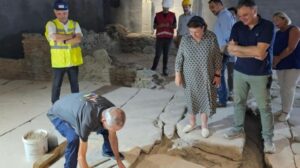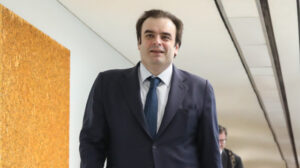The Minister of Culture Lina Mendoni, as part of the systematic working visits that she makes, from 2019, in the metro stations of Thessaloniki, which are underway archaeological work by the competent Ephorate of Antiquities of Thessaloniki City, as stated in a relevant statement of the Ministry of Culture.
At the Venizelos station, the minister was informed by the competent officials of the Ministry of Culture, the managers of “Hellenic Metro” and the representatives of the contractor on the progress of the project of repositioning the temporarily detached antiquities and the final image of the archaeological site with the installation of digital media and applications and other information material placed in the station.
In the presence of the minister, the repositioning of the antiquities was completed with the reinsertion of the first stone, which was detached, on 15 July 2021, when the titanic task of the temporary detachment of the antiquities began, which was decisive for the whole development of the completion of the Thessaloniki metro project.
After the autopsy, the minister said the following:
“When we started the temporary detachment of antiquities at Venizelos station, we were committed that within specific timeframes the detached antiquities would be returned to their exact location, based on the principles of science and ethics, constituting a unique monumental set within the shell of the station. With absolute respect to the institutional framework and the archaeological law, but also to the needs of Thessaloniki and its inhabitants, we are completing an extremely complex archaeological project in the urban fabric of Thessaloniki, a model and innovative project on an international level.
Comprehensive studies have been prepared for all the necessary and legally required stages, for the entire process of posting and repositioning of the antiquities under the continuous and uninterrupted supervision of the Ephorate of Antiquities of Thessaloniki City and the close cooperation of the relevant Directorates of the Ministry of Culture.
All the studies received the positive opinions of the Central Archaeological Council, but also the positive judgment of the Plenary Session of the Council of State, to which those who were ideologically opposed to the construction of the Metro appealed.
Thanks to the daily and systematic cooperation of the Ministry of Culture with Attiko Metro and its contractors, a school for the management, documentation, protection and promotion of the cultural heritage is being created in Thessaloniki, in the context of the construction of a large and complex technical project. We are preserving and highlighting the evidence of the city’s long historical continuity – from its foundation by Cassander to the last centuries – with pioneering and innovative solutions, using modern techniques and technologies. Thessaloniki – in the case of the metro – is leading the way, as it now has an extensive archaeological site integrated into the shell of the station. We are actively showing our respect for the past, present and future of the city and its citizens.”
According to the announcement of the Ministry of Culture, at the Venizelos station, all of the earliest building and chronological phases of Thessaloniki, from the Hellenistic period, are documented in an absolute way. With the research carried out, until recently unknown archaeological fields were investigated as, after the detachment of the layers of the late antiquity, antiquities of Roman times were investigated. The area of the Venizelos Station is 1,260 sq.m. but the archaeological survey covered at least 3,500 sq.m. The founding phase of the city of Kassandrous was revealed, which developed according to the Hippodamian system, on the same roads, with minor displacements. The layers of the Hellenistic and Roman main road were revealed, which was flanked to the south by the pessostiriki stoa, which provided access to the building island.
Lina Mendoni then carried out autopsies at the “Agia Sophia” and “Syntrivani” stations. At the station “Agia Sophia”, at its northern entrance, the Ephorate of Antiquities of Thessaloniki completed the work of highlighting and presenting to the public a new very important archaeological site of more than 800 square meters, which was revealed in the context of the technical project of the station’s construction. The “Fountain” station is one of the eight metro stations where antiquities were uncovered. Part of the movable antiquities – along with the relevant information material – will be permanently exhibited within the station’s shell.
During the autopsies at the metro stations, the minister was accompanied by the Secretary General of Culture George Didaskalou, the Director of Prehistoric and Classical Antiquities Elena Kountouri, the Director of Byzantine and Post-Byzantine Antiquities Ioulia, Papageorgiou, the Head of the Ephorate of Antiquities of Thessaloniki City, Elisavet Tsigarida and the Head of Prehistoric and Classical Antiquities of the Ephorate of Thessaloniki City, Tania Protopsaltis.
Ask me anything
Explore related questions





